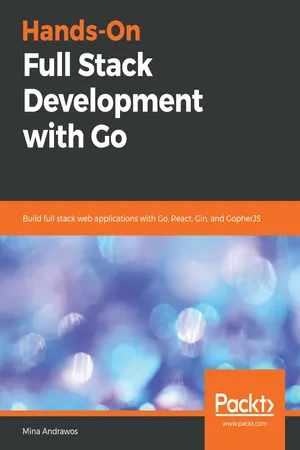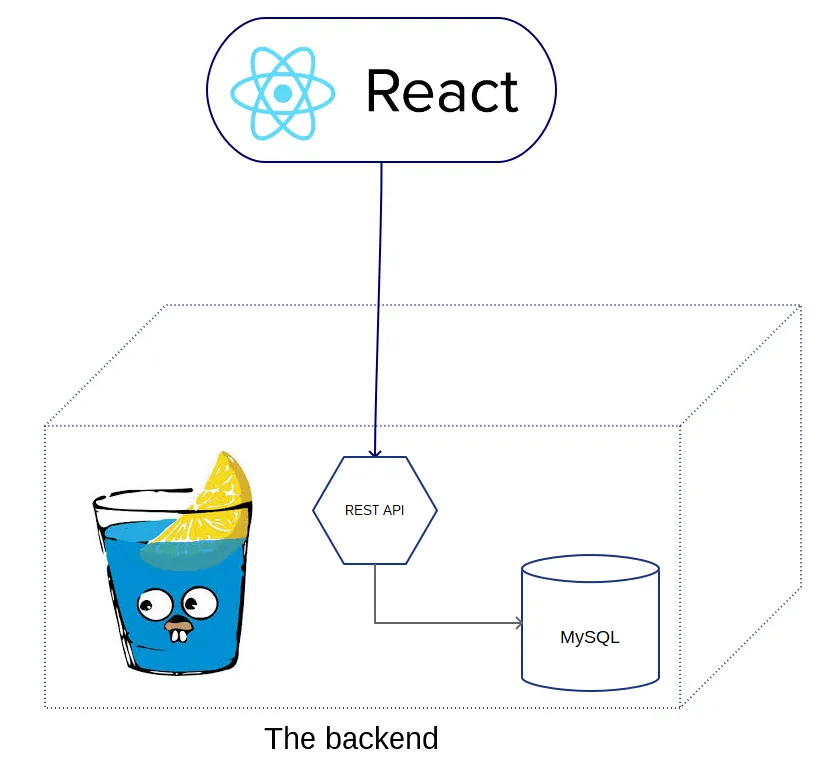
Hands-On Full Stack Development with Go
Build full stack web applications with Go, React, Gin, and GopherJS
- 324 pages
- English
- ePUB (mobile friendly)
- Available on iOS & Android
Hands-On Full Stack Development with Go
Build full stack web applications with Go, React, Gin, and GopherJS
About This Book
Create a real-world application in Go and explore various frameworks and methodologies for full-stack development
Key Features
- Build a responsive front end by using the powerful React framework
- Build web APIs and middleware in the Go language by making use of the popular Gin framework
- Build an Isomorphic Go React application via GopherJS
- Perform unit tests, and benchmarking on your web API
Book Description
The Go programming language has been rapidly adopted by developers for building web applications. With its impressive performance and ease of development, Go enjoys the support of a wide variety of open source frameworks, for building scalable and high-performant web services and apps. Hands-On Full Stack Development with Go is a comprehensive guide that covers all aspects of full stack development with Go.
This clearly written, example-rich book begins with a practical exposure to Go development and moves on to build a frontend with the popular React framework. From there, you will build RESTful web APIs utilizing the Gin framework. After that, we will dive deeper into important software backend concepts, such as connecting to the database via an ORM, designing routes for your services, securing your services, and even charging credit cards via the popular Stripe API. We will also cover how to test, and benchmark your applications efficiently in a production environment. In the concluding chapters, we will cover isomorphic developments in pure Go by learning about GopherJS. As you progress through the book, you'll gradually build a musical instrument online store application from scratch.
By the end of the book, you will be confident in taking on full stack web applications in Go.
What you will learn
- Understand Go programming by building a real-world application
- Learn the React framework to develop a frontend for your application
- Understand isomorphic web development utilizing the GopherJS framework
- Explore methods to write RESTful web APIs in Go using the Gin framework
- Learn practical topics such as ORM layers, secure communications, and Stripe's API
- Learn methods to benchmark and test web APIs in Go
Who this book is for
Hands-On Full Stack Development with Go will appeal to developers who are looking to start building amazing full stack web applications in Go. Basic knowhow of Go language and JavaScript is expected. The book targets web developers who are looking to move to the Go language.
Frequently asked questions
Information
Section 1: The Go Language
- Chapter 1, Welcome to Full Stack Go
- Chapter 2, Building Blocks of the Go Language
- Chapter 3, Go Concurrency
Welcome to Full Stack Go
- What is full stack development?
- What will we build?
- The outline of this book
What is full stack development?
What will we build?

The application architecture

The outline of this book
- In Chapter 2, Go's Building Blocks, and Chapter 3, Go Concurrency, we will take a deep and a practical tour into the Go language. You will learn about some of the key features of the language, as well as some of its popular design patterns.
- In Chapter 4, Frontend with React.js, and Chapter 5, Building a Frontend for GoMusic, we will cover how to build beautiful and responsive frontend applications using the React.js framework. This is also where we'll start building our GoMusic web application. We will cover React's building blocks, design patterns, best practices, and more. The majority of the frontend code of the book project will be covered in Chapter 4, Frontend with React.js, and Chapter 5, Building a Frontend for GoMusic; however, we won't cover every single line of JavaScript code, so as not to lose focus. All the code will be available in the GitHub repository for this book.
- In Chapter 6, RESTful Web APIs in Go with the Gin Framework, and Chapter 7, Advanced Web Go Applications with Gin and React, we will start building our backend code using the Gin framework. We will cover RESTful APIs, ORMs, secure web connections, and more.
- In Chapter 8, Testing and Benchmarking Your Web API, we will learn how to test and benchmark our Go code using Go's testing package, and the best practices in the industry.
- In Chapter 9, Introduction to Isomorphic Go with GopherJS, we will go through a crash course in isomorphic Go programming. Isomorphic Go programming is the practice of using Go for both the frontend and the backend. This is possible through the GopherJS framework. Chapter 9, Introduction to Isomorphic Go with GopherJS, is a standalone chapter, as it doesn't attempt to rebui...
Table of contents
- Title Page
- Copyright and Credits
- Dedication
- About Packt
- Contributors
- Preface
- Section 1: The Go Language
- Welcome to Full Stack Go
- Building Blocks of the Go Language
- Go Concurrency
- Section 2: The Frontend
- Frontend with React.js
- Building a Frontend for GoMusic
- Section 3: Web APIs and Middleware in Go
- RESTful Web APIs in Go with the Gin Framework
- Advanced Web Go Applications with Gin and React
- Testing and Benchmarking Your Web API
- Introduction to Isomorphic Go with GopherJS
- Where to Go from Here?
- Other Books You May Enjoy